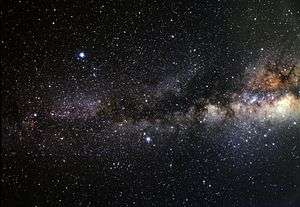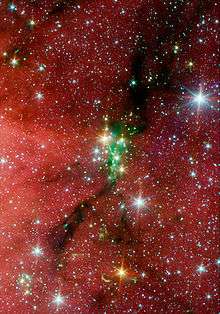Serpens-Aquila Rift
The Serpens-Aquila Rift (also known as the Aquila Rift) is a region of the sky in the constellations Aquila, Serpens Cauda, and eastern Ophiuchus containing dark interstellar clouds. The region forms part of the Great Rift, the nearby dark cloud of cosmic dust that obscures the middle of the galactic plane of the Milky Way, looking inwards and towards its other radial sectors. The clouds that form this structure are called "molecular clouds", constituting a phase of the interstellar medium which is cold and dense enough for molecules to form, particularly molecular hydrogen (H2). These clouds are opaque to light in the optical part of the spectrum due to the presence of interstellar dust grains mixed with the gaseous component of the clouds. Therefore, the clouds in the Serpens-Aquila Rift block light from background stars in the disk of the Galaxy, forming the dark rift. The complex is located in a direction towards the inner Galaxy, where molecular clouds are common, so it is possible that not all components of the rift are at the same distance and physically associated with each other.[6]
| Dark nebula | |
|---|---|
 In this image of the Milky Way, the Aquila Rift is the dark patch right of center. It is part of the Great Rift which can be seen bisecting the swath of star light seen in the galactic plane. | |
| Observation data: J2000.0 epoch | |
| Right ascension | 19h 07m |
| Declination | +01° 00′ |
| Distance | 750–1650 ly (225–500[1][2][3][4] pc) |
| Apparent dimensions (V) | 20 × 10° [5] |
| Constellation | Aquila, Serpens, Ophiuchus |
| Notable features | – |
| Designations | Aquila Rift |
Several star-forming regions are projected in (or near) the direction of the Serpens-Aquila Rift, including Westerhout 40 (W40),[4][7] Serpens Main,[8] Serpens south,[9] Serpens NH3,[10][11] and MWC297/Sh2-62.[11][12]
Distance
Parallax measurements have been used to determine the distance to some of the stars clusters thought to be related to the Serpens-Aquila Rift. The distances to both W40 and Serpens-South were measured to be 436±9 pc (1420±30 light-years) using astrometric measurements of several cluster members observed with the Very Long Baseline Array (VLBA).[1] For radio sources the Serpens Main star cluster, parallax measurements from the VLBA give a distance of 415±15 pc. The similarity in distance is consistent with the idea that these discrete star-forming regions are part of the same star-forming complex. Distances to molecular clouds and star-forming regions in the Milky Way Galaxy have, historically, been difficult to constrain.[7][6] These VLBA measurements for W40, Serpens-South, and Serpens Main were among the most-accurate distance measurements for massive star-forming regions in the pre-Gaia era.[1]
An earlier distance estimate to the cloud was found by counting the number of stars in front of the Serpens-Aquila Rift and using statistical models of the distribution of stars in the Galaxy. This method suggests that stars begin to be obscured by the clouds at a distance of 225±55 pc.[2][13]
Star formation


In the Serpens-Aquila Rift, the largest cluster of young stars is in the W40 nebula, which contains approximately 500 pre–main-sequence stars[4][7] and the massive O-type star IRS 1A South.[14] Serpens Main is another young cluster in which over 100 young stars have been discovered.[8] Observations by the Spitzer Space Telescope revealed the Serpens south stellar nursery within a dense molecular filament.[9] Class 0 protostars have been identified by millimeter radio observations of Westerhout 40 and Serpens South.[15]
Serpens South is a star cluster embedded in a dense molecular filament containing numerous protostars.[9] Due to the large number of protostars and pre-stellar cores in the region, it is likely that Serpens South has the most star-formation activity in the Serpens-Aquila Rift.[15] A large scale magnetic field was discovered in the region which is perpendicular to the main cloud filament, but sub-filaments tend to run parallel to the filament.[16] This magnetic field may be responsible for slowing the gravitational collapse of molecular clumps in the complex.[17]
The Herschel Space Observatory has made a map of this region of the sky in mid- and far-infrared wavelengths.[18] The molecular cloud at these wavelengths is traced by emission from warm dust in the clouds, allowing the structure of the clouds to be probed. Wavelet analysis of the molecular clouds in the approximately 11 square degree Herschel field of view breaks up the clouds into numerous filaments, mostly in and around the Westerhout 40 region.[19] A number of possible "starless cores"—over-dense clumps of gas that may gravitationally collapse to form new stars—are also noted in this region, mostly studded along the molecular filaments.[20] Millimeter observations from the IRAM 30m telescope provide confirmation for 46 of the starless-cores and Class 0/I protostars in the Westerhout 40 and Serpens south regions.[15]
In culture
The Aquila Rift was featured in the short story "Beyond the Aquila Rift" by Alastair Reynolds in the 2005 science-fiction anthology Constellations.[21] In the space simulator video game, Elite Dangerous, Commanders are able to travel to this region of space.
See Also
References
- Ortiz-León, G. N.; et al. (2016). "The Gould's Belt Distances Survey (GOBELINS) III. The distance to the Serpens/Aquila Molecular Complex". Astrophysical Journal. 834: 143. arXiv:1610.03128. Bibcode:2017ApJ...834..143O. doi:10.3847/1538-4357/834/2/143.
- Straižys, V.; et al. (1996). "Interstellar extinction in the area of the Serpens Cauda molecular cloud". Baltic Astronomy. 5 (1): 125–147. Bibcode:1996BaltA...5..125S. doi:10.1515/astro-1996-0106.
- Dzib, S.; et al. (2011). "VLBA Determination of the Distance to Nearby Star-forming Regions. IV. A Preliminary Distance to the Proto-Herbig AeBe Star EC 95 in the Serpens Core". Astrophysical Journal. 718 (2): 610–619. arXiv:1003.5900. Bibcode:2010ApJ...718..610D. doi:10.1088/0004-637X/718/2/610.
- Kuhn, M. A.; et al. (2010). "A Chandra Observation of the Obscured Star-forming Complex W40". Astrophysical Journal. 725 (2): 2485–2506. arXiv:1010.5434. Bibcode:2010ApJ...725.2485K. doi:10.1088/0004-637X/725/2/2485.
- Prato, L.; et al. (2008). "Where are all the Young Stars in Aquila?". In Reipurth, B. (ed.). Handbook of Star Forming Regions, Volume I: The Northern Sky ASP Monograph Publications. 4. p. 18. Bibcode:2008hsf2.book..683R. ISBN 978-1-58381-670-7.
- Loinard, L. (2013). "The Gould's Belt Distances Survey". Proceedings of the International Astronomical Union. 8: 36–43. arXiv:1211.1742. Bibcode:2013IAUS..289...36L. doi:10.1017/S1743921312021072.
- Kuhn, M. A.; Getman, K. V.; Feigelson, E. D. (2015). "The Spatial Structure of Young Stellar Clusters. II. Total Young Stellar Populations". Astrophysical Journal. 802: 60. arXiv:1501.05300. Bibcode:2015ApJ...802...60K. doi:10.1088/0004-637X/802/1/60.
- Winston, E.; et al. (2007). "A Combined Spitzer and Chandra Survey of Young Stellar Objects in the Serpens Cloud Core". Astrophysical Journal. 669 (1): 493–518. arXiv:0707.2537. Bibcode:2007ApJ...669..493W. doi:10.1086/521384.
- Gutermuth, R. A.; et al. (2008). "The Spitzer Gould Belt Survey of Large Nearby Interstellar Clouds: Discovery of a Dense Embedded Cluster in the Serpens-Aquila Rift". Astrophysical Journal. 673 (2): L151–L154. arXiv:0712.3303. Bibcode:2008ApJ...673L.151G. doi:10.1086/528710.
- "NAME Serpens G3-G6 Cluster". SIMBAD. Centre de données astronomiques de Strasbourg.
- Bontemps, V.; et al. (2010). "The Herschel⋆ first look at protostars in the Aquila rift". Astronomy & Astrophysics. 518: L85. arXiv:1005.2634. Bibcode:2010A&A...518L..85B. doi:10.1051/0004-6361/201014661.
- "LBN 026.83+03.54". SIMBAD. Centre de données astronomiques de Strasbourg.
- Straižys, V.; et al. (2003). "Interstellar extinction in the direction of the Aquila Rift". Astronomy & Astrophysics. 405: 585–590. arXiv:astro-ph/0303099. Bibcode:2003A&A...405..585S. doi:10.1051/0004-6361:20030599.
- Shuping, R. Y.; et al. (2012). "Spectral Classification of the Brightest Objects in the Galactic Star-forming Region W40". Astronomical Journal. 144 (4): 116. arXiv:1208.4648. Bibcode:2012AJ....144..116S. doi:10.1088/0004-6256/144/4/116.
- Maury, A. J.; et al. (2011). "The formation of active protoclusters in the Aquila rift: a millimeter continuum view". Astronomy & Astrophysics. 535: 77. arXiv:1108.0668. Bibcode:2011A&A...535A..77M. doi:10.1051/0004-6361/201117132.
- Sugitani, K.; et al. (2011). "Near-infrared-imaging Polarimetry Toward Serpens South: Revealing the Importance of the Magnetic Field". Astrophysical Journal. 734 (1): 63. arXiv:1104.2977. Bibcode:2011ApJ...734...63S. doi:10.1088/0004-637X/734/1/63.
- Tanaka, T.; et al. (2011). "The Dynamical State of the Serpens South Filamentary Infrared Dark Cloud". Astrophysical Journal. 778 (1): 34. arXiv:1309.2425. Bibcode:2013ApJ...778...34T. doi:10.1088/0004-637X/778/1/34.
- André, Ph.; et al. (2010). "From filamentary clouds to prestellar cores to the stellar IMF: Initial highlights from the Herschel Gould Belt Survey". Astronomy & Astrophysics. 518: L102. arXiv:1005.2618. Bibcode:2010A&A...518L.102A. doi:10.1051/0004-6361/201014666.
- Men'schikov, A.; et al. (2010). "Filamentary structures and compact objects in the Aquila and Polaris clouds observed by Herschel". Astronomy & Astrophysics. 518: L103. arXiv:1005.3115. Bibcode:2010A&A...518L.103M. doi:10.1051/0004-6361/201014668.
- Könyves, V.; et al. (2010). "The Aquila prestellar core population revealed by Herschel". Astronomy & Astrophysics. 518: L106. arXiv:1005.2981. Bibcode:2010A&A...518L.106K. doi:10.1051/0004-6361/201014689.
- Crowther, Peter, ed. (2005). Constellations: The Best of New British SF. Penguin Group USA. ISBN 0756402344.